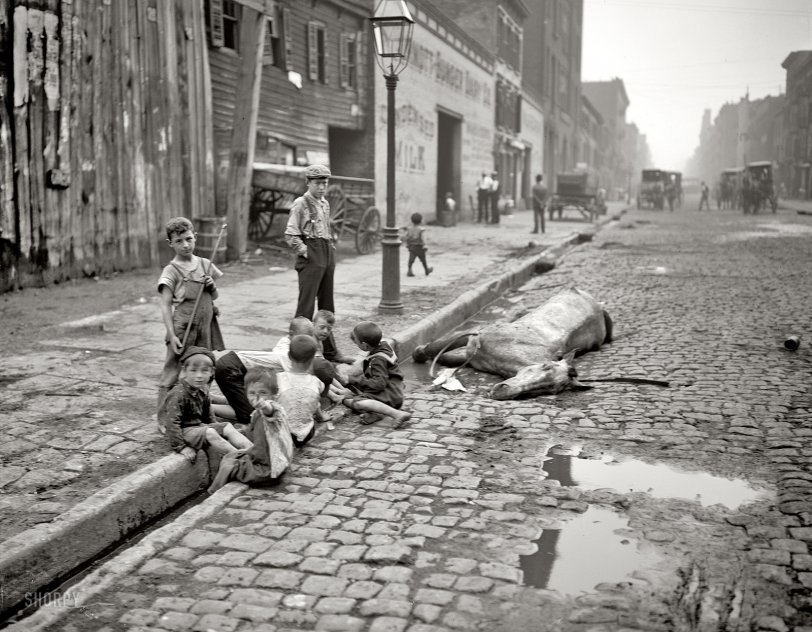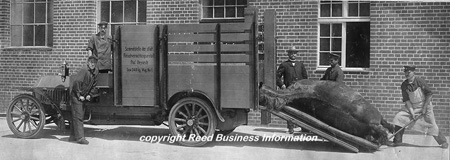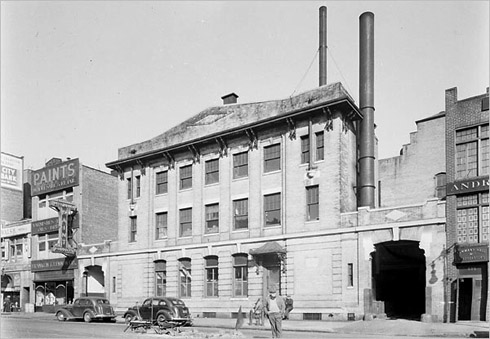


Framed or unframed, desk size to sofa size, printed by us in Arizona and Alabama since 2007. Explore now.
Shorpy is funded by you. Patreon contributors get an ad-free experience.
Learn more.

- Roll your own
- Rugged and real!
- A Charles Purcell - Mama Cass Connection
- Uncle SAAM
- Obfuscation
- One Chocolate Soldier rode away
- Victor Marquis de la Roche
- The Little House Across Way ...
- Vanderbilt Gates
- Vanderbilt Mansion
- You can still see that gate
- Withering heights for me
- So Jim,
- Top Heavy
- Re: Can't Place It.
- Bus ID
- Since you mention it
- The White Pages ?
- Moonlight Tower
- 1907?
- Fire(men) and Water
- Can't Place It
- Can anyone
- Wings
- Where's Claudette and Clark?
- Overbuilt Rolodex
- One song
- Give Me Wings Please!
- PRR
- Pinball Wizards
Printporium
Dead End: 1905

Circa 1905. "The close of a career in New York." Photo by Byron. 8x10 inch dry plate glass negative, Detroit Publishing Company. View full size.
Possible Location ...
I have been spent a little while trying to solve the puzzle of where the location of this picture was and I may have found it. Not only was the McDermott-Bunger Dairy located at 527 West 125th Street in NYC, but they also had an additional location at 525-531 West 38th Street in NYC. I have found several references to this, including one in a November 1902 issue of the Jefferson County Journal (of Adams, NY.) Unfortunately, when I looked at the location on Google maps, I found an open space that is an overpass for one of the entrance/exit ramps to the Lincoln Tunnel. Additionally, there are no old buildings that are identifiable on the block.
That's Life (& Death)
I am new to this site but must comment on this picture. I grew up in Brooklyn in the 1950s. There was a livery stable on Dean Street where peddlers stored their wagons and boarded their horses. Occasionally a horse would die and wind up in the street just like this. The owner of the stable would cover it with a blanket (presumably to keep the flies off) until the Department of Sanitation (around the block on Pacific Street) could pick it up. I remember one instance where we kids watched as the dead horse was winched onto a flatbed truck and hauled away. Horses (even the most loved and well-cared for) die, as do all living things eventually. The horse in the photo may well have been 25 to 30 years old.
The kids
I agree that this is a sad picture, but alas, it is real life. The horse does not look that well fed, but perhaps it is because it was ill, not starved. What I really find interesting is how many kids are just sort of running around on their own - no supervision, no shoes, and that one little guy on the sidewalk by himself looks no more than 3 or 4.
Thanks for this picture
A sad photograph, but an interesting one that shows something about history that we don't ordinarily think about much. That's what I like about this site: old photographs show us the forgotten details.
For me the most telling thing is that the kids are more interested in the camera than they are in the horse. It's not that the kids are particularly inhumane, but for them a dead horse isn't all that unusual. A camera is. And is that so bad, for children to focus on the new? I'm sad for the horse, but let's not forget the kids. They're vibrant, alive, interested in new things around them and in each other, even in the face of death and their own poverty. There's hope here.
Yes, not 125th
Greetings -- just discovered this fantastic site. Amazing stuff. Kudos to webmaster Dave.
Adding to what's probably already been confirmed, a friend on 126th Street notes that while the photo of the dairy (comments, 1/21, 9:06) is definitely West 125th (Manhattan Ave, as it was called around the time that pic was taken), the picture of the dead horse does not look like West 125th. There is no place on West 125th that has that kind of perspective, straight to the vanishing point. It could possibly be East 125th, or, much more likely, someplace well downtown from there.
Horses still need disposal
I worked for the National Park Service for many years and we had mounted patrol rangers who rode the back country trails. I vividly remember the card we kept in the Rolodex file for a "dead horse removal" service.
Never had to call on them, thank god.
Our horses were loved and cared for like no others (a small army of volunteers assisted in feeding and currying) but they were still animals that might fall victim to sickness or injury.
Blogging a dead horse
This was a common sight in any big city at the time. Just because this horse is on the street waiting to be picked up does not necessarily mean that the animal died from abuse. I wrote an article last year about the history of carriage horses in New York, and in the course of my research I found numerous pictures just like this (and none of the horses in the pictures looked "healthy," probably because they were, you know, dead). Freak accidents, disease, and simple wear and tear from years of pulling carriages on the city streets are just a few of the things that could send a horse to an early grave.
Although it may seem sad, horses in this era were still considered a means to an end, and their usefulness was determined by how much they could work. I'm sure that there were owners that mourned the death of a cherished animal, but truthfully people around the turn of the century were generally a bit more realistic about the inevitability of death than we are today.
Losing the rose-tinted glasses
I've been enjoying the photographs on Shorpy.com for over the year now. During that time, I noticed a certain tendency of some commentators to shake heads at our present while nostalgically looking at pictures of men and women of the past century. I hope this photo will serve as a sharp reminder of how primitive and brutal life could be in a average Western metropolis, barely a century ago.
Mind you, I don't think present times are anywhere close to utopia. But comparing the place I live in today with the way it was a hundred years ago... I'd say I'm better off then my grand-grandparents.
Thanks, Dave
Put me in the category of readers who appreciate photos like these. The great thing about so many of these historical photos is that they show the dirty fingernails and the sweat-soaked clothes of past times, not just picture-postcard views of town and country. When thousands of horses pulled thousands of carts, wagons, and carriages through cities every day of the week, some horses obviously died. Let's not be so meek and prim that we complain about seeing photos that depict everyday reality. If you're too fragile to view these photos, maybe the problem is with you, rather than the truth portrayed in the photos. And Shefindsu, what makes you think any cruelty was involved in this horse's death? The horse doesn't look "starved and unkempt" to me. He just looks dead. Geez, people, get a grip.
On Photographers
An eloquent, honest, even wrenching photo. And it has inspired a range of emotions. This is what the best photography does - beyond the merely documentary. Thanks for unearthing and posting this.
Cost of Horsepower
The fate of horses worked to death, and elimination of their droppings from the street, were big reasons why automobiles were looked on as a great advancement. By comparison, automotive smoke and oil drips seem minor.
This way to the Egress.
The comments regarding the "depressing" subject remind me of a comment left at the Children's Museum at a certain major Canadian institution when I worked there. "You should only put up pictures of pretty things like flowers and butterflies instead of the Satanic things you have" (which were, amongst other things, costumes from other countries and an inflatable igloo).
I, for one, am glad that no punches are pulled, here. Life isn't always flowers and butterflies.
A great photo
Sure it's depressing, but it's as real as the pictures of death taken by Mathew Brady during the Civil War.
When I was a kid in New York, circa 1944 to 1948, there were still a number of horses drawing vendors' carts. Vegetables, rags, and a knife sharpener were the ones I remember. I also remember a traditional organ grinder with a monkey, and guys building skyscrapers tossing red hot rivets through the air.
Great Photo Dave!
Not sure what everyone's gripe is about you posting this photo. As a history buff, I am thankful that such photos are available to view. They give us a peek into history, and the way things were.
Look at their faces
I see an obvious resigned sadness in each little boy's face over the demise of the equine as though, even at their tender ages, they accept the sorrowful but inevitable finality of death. Even the kid that has spotted the photographer wears an undermask of mourning. (Yeah, I am one of those morose drinkers who cries in my beer). The poor horse was a good animal, he didn't deserve this. He served his master well, worked his carcass off and this is how it all ends up. Where is the justice?
For Cactus Wren
Not to get in an argument with you, but I recently read "Time and Again," a work of FICTION, which was written in 1970. I didn't get the idea from reading it that 1882 was such a fabulous and glorious time to live in. In fact, there's a part in the book where the main character Simon Morley is riding in a taxi and discussing with the driver the poverty he and his family live with constantly. If people really want to know how the "Other Half" lived, they ought to read Jacob Reis.
You can do better, Dave
Jesus, man - don't we see enough death and violence in modern media? You can actually select the pics you post, right?
[Boo-hooey. - Dave]
Any architectural historians out there?
The clapboard house next to the dairy looks considerably older than the brick structures elsewhere on the street. Any clues as to its potential age? It looks fairly rattletrap when this photo was taken.
Is this a Saturday or in the summertime - or are all these boys playing truant? And I bet none of them wash their hands before eating.
I could have lived the rest of my life
without seeing this photo. Why oh why did I click on this email this morning? Ok, I'm a woman who loves animals, babies, children etc. I'm no member of Peta and I eat meat but this picture is heartbreaking. To see a magnificent animal like the horse lying in a ditch looking starved and unkempt just makes me want to cry. I wish I could go back to that time and whip that owner for abusing that horse the way he did. This just makes me even more thankful for our modern ASPCA. I hope this horse is in horse heaven now galloping over the hills and valleys of heaven and eating all the oats he desires. Please don't reply about all the other misfortunate beings that existed then. I'm not really interested.
Look at the old faces
These kids had such old looking faces...this was the most depressing photo yet...interesting, but depressing!
We tripped the light fantastic on the sidewalks of New York
Well, a few of us, anyways. Others, not so much.
Dave, some of the photos you find astonish me. They have changed me. This is one of the saddest ever.
Another note re: Jack Finney
Another note re: Jack Finney and his wonderful book, "Time and Again", as posted by Cactus Wren. I've read it at least three times over the years, and it would be a book that I'd want to have with me to read once again, if marooned on a desert island.
The Knackers Truck
Getting a dead horse up off the street was hard work. Here is a photo of one being winched into what looks like an early Daimler municipal knacker's truck somewhere in Germany.

"Mind your horse for you, Mister?"
The kid in the flat cap looks a bit guilty to me.
I think the older boy cares.
Though horse death was a regular part of life in the dairy delivery business I'm sure people did get attached to some of the animals. When the time came a horse had to be gotten out of the property and out to the street where the carcus could be picked up. I'm thinking the boy with shoes and a hat works in the stable and has been tasked with waiting for the pickup. I'm also thinking he is not too happy with the task nor what has happened to one of his charges. It's entertainment for the kids and it's a responsibility for him. His affect says, "Aw crap, this sucks."
West Side Dairy
There was another McDermott-Bunger facility at 525-27 West 38th Street.
Google Street View
Before too many people post Google Street Views of 527 West 125th Street (the address noted in the excellent comment below), two observations.
1. 527 West 125th Street is the address of the dairy (photo below), not of the rundown stable whose entrance is shown in the dead-horse photo. Dairy and stable not necessarily same street address!
2. Please DO NOT make a screen grab of a Google Street View and then upload the screen grab here or elsewhere. If you want to show a Google Street View in the comments box, all you need to do is copy and paste the Google "embed" code, which is super-easy.
Thank you and good day.

Not ready for a poke.
You really want to wait a day or so, until the legs on top are lifted skyward, before poking the horse with a stick. Grew up in cattle country, and had the chance to do so as a kid.
Great photo, this one, for showing what life was like. Also enjoyed the Little Italy 1900 view posted today (or was that yesterday?).
In the movies from that era
I always wondered why even really poor people were always clean and had good teeth. Also thought it was strange that there were never any dead horses in the streets--except the ones shot in gun battles.
McDermott-Bunger Dairy
The McDermott-Bunger sign is a clue. The company built a new dairy at 527 West 125th Street in 1903 (NY Times), so the delivery stable was probably not too far away.
Beginning in the 1860s, factories producing lumber, paint, beer, dye and other materials cropped up on the far western end of Manhattan Valley, around what is now West 125th Street, with its direct connections to the rail line along the Hudson River and the ferry.
While I am loath to beat a dead horse, I speculate this photo was shot in that area.
Stop right there boyo!
Don't you dare poke that animal with that stick.
The smell
I would not last very long in the olden days. Gag.
For Jack Finney
If I could dedicate a photograph from this site, I'd dedicate this one to Jack Finney, author of "The Third Level," "I Love Galesburg in the Springtime" and the novel "Time and Again," among dozens of stories all focused on the notion that any normal, healthy, sane person would want to flee the oppression of modern life and escape to the healthier and more beautiful world of 1905. Which, in Finney's mind, apparently consisted entirely of men in straw boaters, women in leg-o'-mutton sleeves, and band concerts in the park on summer evenings.
There are no dead half-starved horses in Finney's world, no ragged children, no shaved heads to get rid of the lice (note the extremely short haircuts on a couple of these kids), no mud.
That's why I love this site: it's like getting a glimpse into the past, unfiltered by the wishful thinking of modern filmmakers or fictionalists.
Nowadays
he'd be plastered with tickets.
Future Glue
Fascinating photo. Apparently this was a very common sight. NYC had men with wagons in place to pick up carcasses and bring them to rendering plants, many of which were located next to Dead Horse Bay in Brooklyn. I hear that bones are still occasionally found!
Urban Archaeology
Who'll be the first to figure out what street this is?
























On Shorpy:
Today’s Top 5